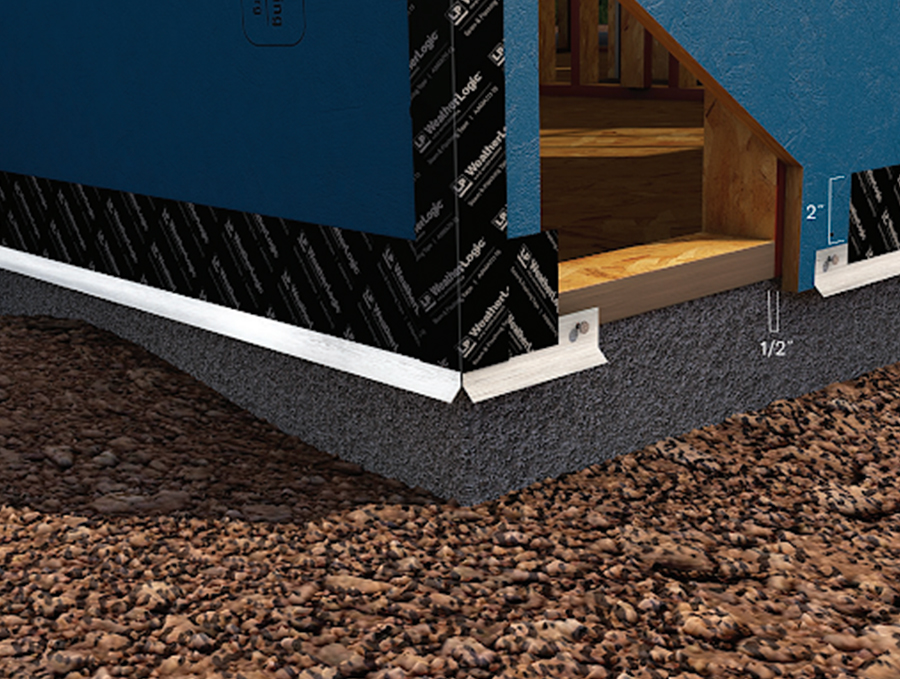Business Advice3 min
Installation Advice: Should Wall Sheathing Overlap Foundation?
Whether most of your construction projects use engineered wood, plywood or OSB, proper wall sheathing installation helps protect the home from wind and water penetration. Installing wall sheathing panels is fairly straightforward, yet one question we do see on social media is whether sheathing should overlap the foundation.
Should sheathing overlap foundation?
The advice when installing wall sheathing is to overlap and install flashing, providing a means to direct moisture away from the foundation. Pros often seal the sill when the wall sheathing overlaps the sill plate. The installation instructions for LP WeatherLogic panels are:
When the panel is flush with the face of the foundation, provide a 1/2-inch gap between the bottom edge of the panel and the foundation.
Attach approved drip edge when required by code.
Apply LP WeatherLogic® Seam & Flashing Tape to seal the top of the drip edge. The tape should extend at least 2 inches past each end and extend at least 2 inches onto the panel face and cover all fasteners used to attach the drip edge.
If the fasteners are placed so that the standard 3-3/4-inch tape cannot cover and extend 2 inches onto the panel, use the 6-inch tape or shingle multiple rows of 3-3/4-inch tape so that a layer above overlaps the layer below.

Builder Kyle Stumpenhorst of @rrbuildings recently constructed a 16-foot-tall building with an irregular foundation, and before he started installing LP WeatherLogic panels he marked reference lines. “We're running our WeatherLogic sheets vertically,” says Stumpenhorst. “We won't have a consistent, single line because we can't snap from on our foundation.” Check out the full installation process in the video below.
Stumpenhorst said the foundation had some variances. "We don't want to start at the foundation and move up. We're going to mark from the soffit down so we can establish two lines," he said.
The 16-foot-tall building naturally aligned with 4-foot by 8-foot dimensions of the LP WeatherLogic panels. "We laid out all the framing so that we would have very little to no waste while installing the sheathing." In this application, he used a 4-foot piece near the foundation, an 8-foot piece above it, and then a 4-foot piece. For the next section, he installed two 8-foot sections. He finished with the first 4x8x4 combination.
For more quick tips, be sure to follow #LPQuickTip on Instagram. Want to see more from these pro builders? Check out this modern farmhouse build.
Continue Reading
Resiliency Solutions
5 minIntroducing LP® SmartSide® ExpertFinish® Naturals Collection™: Nature-Inspired Beauty Meets Engineered Performance
We're excited to introduce the LP® SmartSide® ExpertFinish® Naturals Collection™, a bold new addition to our trusted line of engineered wood siding and trim that delivers the warmth and beauty of nature with the advanced protection and performance builders and homeowners expect.
Labor Solutions
5 minChoosing the Right LP® Structural Solutions Product for Your Build
When it comes to building strong, reliable, and high-performing structures, the materials you choose matter. At LP Building Solutions, we understand that every project, whether it's a single-family home or a multifamily development, requires structural components that meet your needs for strength, durability, and efficiency.
Sustainability Solutions
5 minBuilding a More Sustainable Future with LP Building Solutions
In today's world, sustainability is no longer just a buzzword, it's a blueprint for responsible living and smarter building. As the construction industry seeks ways to reduce its environmental footprint, LP Building Solutions is focused on providing innovative building materials for eco-conscious builders to help reshape what it means to build sustainably
News & Stories3 min
History of Partnership with Gary Sinise Foundation
The LP Foundation is a proud partner of the Gary Sinise Foundation, which supports wounded veterans in several ways. You can learn more about the LP Foundation here.